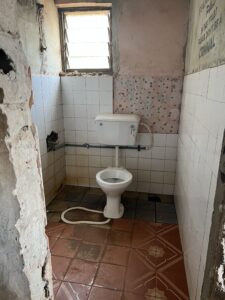
WASH field report
By Dr Babatope Babalobi and Racheal Ogundipe
A team from eWASH visited The Anglican Grammar School (Senior school) on the 16th of March, 2023, for our routine assessment of the school’s Water, Sanitation and Hygiene (WASH) facilities. Before starting the assessment, we met with the school vice principal, Mrs M.B Onilogbo, to discuss the purpose of our visit. We were well received, and she briefed us on the current WASH status of the school. She mentioned that the school has over 1500 students and a total number of 37 staff. The school has an environmental committee, which comprises only teachers. However, there are health prefects, male and female.
Despite this large number of students, they still do not have a toilet they use. She added that their toilet, which was a pit latrine, was filled up, and they have not been able to afford the cost of evacuation of the pit latrine. The students mostly practice open defecation around the school. She added that she had reported to the Local Government at the Water supply and Environmental sanitation department regarding the evacuation, but nothing has been done. The school alumni were also informed and met for assistance regarding this problem but have yet to get feedback. She also considered digging new pit latrines because it would cost less than the evacuation of the previous Pit latrine they had. Based on her calculations, the evacuation cost per trip is 70,000 Naira, while it will cost less to make new pits. The teachers, on the other hand, have 4 toilets, but only 3 are functioning. The toilet is kept clean but still under renovation. Nevertheless, teachers still make use of the toilet.
They use the borehole and have a water supply which is usually treated for the students to drink, and students have access to them whenever they need water. The water appears to be clean and in a good environment. She also added that they have a Gp tank for the toilet, but it’s not being used now that it is filled up.
We proceeded to make our observations, and some of the things that we set out to observe were:
- The sources of drinking water in the school.
- History and causes of waterborne illnesses such as diarrhoea or cholera
- Availability of gender-sensitive toilets in the school
- Students toilet usage
- Availability of water in toilets and the cleanliness and those responsible for the cleanliness.
- Presence of handwashing facilities in the toilet, such as Soap and Water
- Attention to privacy for proper menstrual hygiene facilities and materials such as water, access to sanitary pads, waste bins, private space, etc.
- Water, sanitation, and hygiene challenges as a student
Our findings as summarised below
- The students practice open defecation in the bushes around the school, but the classroom environment is clean
- They are still defecating on the floor of the filled-up toilet
- There are 4 staff toilets with 3 still in good shape
- They practise open dumping of all their waste but burn it daily before school ends.
- They are making use of the students to dig a hole (as punishment for misbehaviour) that will serve as an incinerator for the waste
- They have a good water supply for drinking, which is accessible to the students










Recommendations
- Part of the teacher’s toilet should be left for the student to use temporarily while the student’s toilet is being reconstructed.
- The school can reconstruct a pour flush toilet for the students to use or convert the hole dug for incinerating waste into a VIP pit latrine. This is a low-cost option, considering the funding available.
- Stakeholders can be sorted, such as the school alumni, on how to construct a good toilet facility for the school
Leave a Reply